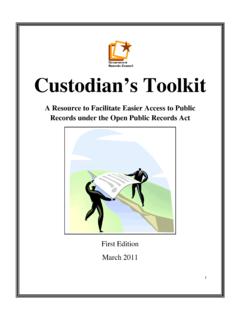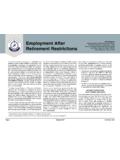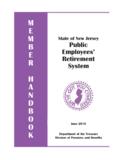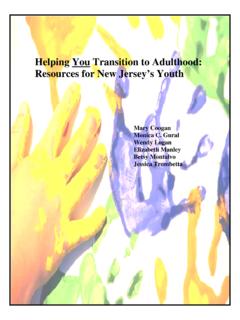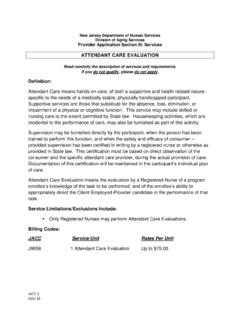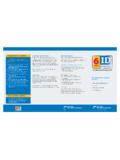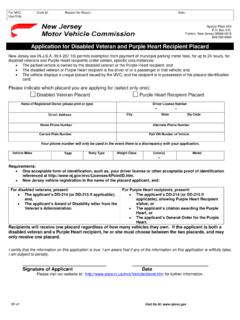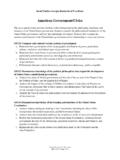Transcription of Visual and Performing Arts NJSLS 2020 (June)
1 2020 New Jersey Student Learning Standards Visual and Performing Arts Introduction Visual and Performing Arts Throughout time, the arts have served as a distinctive vehicle for self-discovery and a means of understanding the world in which we live. As the state of New Jersey continues to transform public education to meet the needs of a changing world and the 21st century workforce, capitalizing on the unique ability of the arts to develop creativity, critical thinking, and innovation skills is critical to the success of our students. The arts infuse our lives with meaning on nearly all levels generating significant creative and intellectual capital. They inspire creative and critical thinking and encourage acceptance of diversity. A well-designed sequential arts program promotes responsible decision making, enhances self-awareness, builds self-esteem and self-management skills, and helps students build relationship and collaboration skills; all of which are essential to prepare New Jersey students for post-secondary success.
2 The New Jersey Student Learning Standards Visual and Performing Arts are designed to promote lifelong artistic literacy and fluency and are guided by the mission and vision statements that follow. Mission To empower students to develop creative and critical thinking, social-emotional competencies, and intellectual and expressive abilities that will allow them to become active, contributing members of a global society. Vision All students will have equitable access to a quality, arts education that leads to artistic literacy and fluency in the artistic practices of the five art disciplines as a mechanism for: Performing , presenting or producing, as artistically literate individuals, by expressing and realizing creative ideas and implementing essential technical skills and cognitive abilities significant to many aspects of life and work in the 21st century; Responding to artistic ideas and work with personal meaning and cognizance of the ability of the arts to address universal themes, including climate change; Creating new artistic work reflective of a variety of ethnic, racial, and cultural perspectives.
3 And Connecting and evaluating how the arts convey meaning through all arts and non-arts disciplines and contexts of our global society. The New Jersey Student Learning Standards for Visual and Performing Arts ( NJSLS -VPA) describe the expectations for literacy and fluency in five artistic disciplines: dance, music, theatre, Visual arts, and media arts. Each artistic discipline has independent skills, knowledge, and content. However, as a field, the arts are interdependent, connected, and inclusive. The NJSLS -VPA are designed to guide the delivery of arts education in the classroom with new ways of thinking, learning, and creating. The vision of all students having equitable access to a quality arts education is only achieved when the five arts disciplines are offered continuously throughout the K 12 spectrum.
4 New Jersey Department of EducationJune 20201 Spirit and Intent The NJSLS -VPA reflect the National Core Arts Standards and emphasize the process-oriented nature of the arts and arts learning by: Defining artistic literacy1 through a set of overarching philosophical foundations and lifelong goals that clarify long-term expectations for arts learning; Placing artistic processes and anchor standards at the forefront of the work; Identifying creative artistic practices as the bridge for the application of the artistic processes and anchor standards across all learning; and Specifying enduring understandings and essential questions that provide conceptual through lines and articulate value and meaning within and across the arts discipline. The development of artistic literacy is dependent on creating an environment in which students are encouraged to independently and collaboratively imagine, investigate, construct, and reflect.
5 Philosophically speaking, the arts serve to communicate ideas, as an opportunity for creative personal realization, to connect and reflect culture and history, and as a means to well-being and a mechanism for problem solving universal, global issues including climate change. Within the broad lifetime goal of preparing artistically literate individuals, learning experiences that engage students with a variety of artistic media, symbols, and metaphors for the purpose of creating and Performing in ways that express and communicate their own ideas are essential. Additionally, to become artistically literate, students need opportunities to respond to the arts through analyzing and interpreting the artistic communications of others. (More examples that illustrate the philosophical foundations and lifelong goals that are the underpinnings of the NJSLS -VPA can be found in the Supplemental Materials section.)
6 New to This Version of the NJSLS -VPA The inclusion of media arts as one of the five arts disciplines is new to this version. Media arts is a unique medium of artistic expression that can amplify and integrate the four traditional art forms. The media artist utilizes a fundamental understanding of the mediums of analog and digital media to integrate digital technologies with traditional forms of artistic expression. The study of media arts can foster new modes and processes of creative thinking within in the realms of the digital and virtual worlds that are evermore present in students lives. In fact, many students are already creating media art on their own and will benefit from support systems within their schools that mirror their life experiences. Because many young people hold a fascination with new media, incorporating media arts study into the school day can potentially enhance the connection between in-school and out-of-school learning and act as motivation for active learning.
7 Also new to this version of the NJSLS -VPA is the specialized approach to music education. To account for various opportunities that students have to engage in music instruction, the NJSLS -VPA include standards for five subdisciplines of music: General Music (grades K 8), Guitar, Keyboard, and Harmonizing Instruments, Traditional and Emerging Ensembles, Composition and Theory, and Music 1 The knowledge and understanding required to participate authentically in the arts. An artistically literate person is able to transfer arts knowledge, skills, and capacities to other subjects, settings, and contexts. New Jersey Department of EducationJune 20202 Technology. At the middle and high school level, students are required to demonstrate proficiency in only one of the preceding subdisciplines. It is important to note that students experiences and course offerings may vary from district to district and that musical literacy and fluency requires compound, scaffolded skills.
8 Accordingly, the music standards are competency-based to allow for multiple points of entry. The novice and intermediate performance expectations for Traditional and Emerging Ensembles, and Guitar, Keyboard and Harmonizing Instruments are generally applicable to elementary and middle school students. The proficient, accomplished, and advanced level performance expectations are generally ascribed to varying degrees of achievement by students in high school. However, a spectrum of increasingly sophisticated achievement level may be attainable throughout the K 12 continuum. Descriptors for Middle School Proficiency Levels in Music At the middle school level (grades 5 8), students may be building on their K 5 experiences or trying a new music specialization based on their interests and course offerings.
9 As a result, the Traditional and Emerging Ensemble and Guitar, Keyboard and Harmonizing Instrument standards describe two levels of attainment: novice and intermediate. Novice Students at the novice level have started specialization in an instrument of their choice. They are beginning to develop the basic artistic understanding of the technique and expressive skills that are necessary to advance their skill level. Novice level students should participate in performance opportunities suitable to their skill level. Their curiosity in music begins their journey toward personal realization and well-being. Intermediate Students at the intermediate level are continuing study in their chosen instrument. Their development continues in artistic understanding and technical and expressive skills enabling the student to begin to independently and collaboratively create, perform , and respond at their given skill level.
10 Intermediate level students should participate in performance opportunities that correspond to their skill level. Through continued study of music, they continue their journey toward personal realization and well-being. Descriptors for High School Proficiency Levels At the high school level (grades 9 12), all students are required to complete five credits in Visual and Performing Arts as part of the course requirements to receive a high school diploma ( 6 ). Because students experiences and course offerings at the middle and high school levels may vary, the new grade 9 12 standards are described in three levels of proficiency. The three levels proficient, accomplished, and advanced are flexible enough to accommodate varying degrees of achievement by students during high school, including those who build on their K 8 foundation by pursuing deeper engagement in one arts discipline, as well as those who explore a wide range of artistic pursuits and experiences at the high school level.
